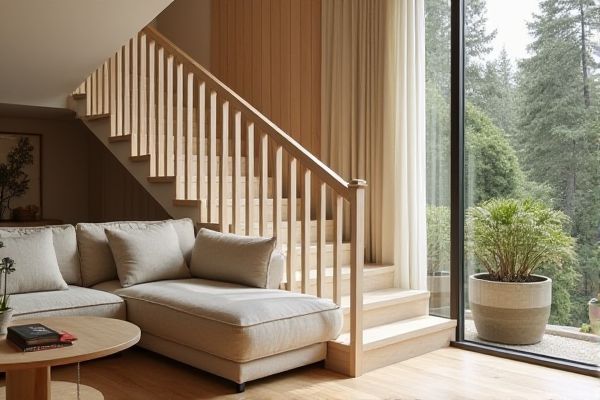
Vertical slat railings offer a traditional, secure look by directing the eye upward and enhancing the perception of height, while horizontal slat railings create a modern, open feel with broader views and a more relaxed aesthetic. Discover which railing style best suits Your outdoor space and design preferences by reading the rest of the article.
Table of Comparison
| Feature | Vertical Slat Railing | Horizontal Slat Railing |
|---|---|---|
| Design Style | Traditional, classic look | Modern, contemporary appearance |
| Privacy | Higher privacy due to vertical alignment | Lower privacy, more open view |
| Safety | Often safer for children, less climbable | Can be climbable, requires extra caution |
| Installation | Generally easier to install | Requires careful alignment and support |
| Durability | Strong structural integrity | Dependent on quality of materials and installation |
| Cost | Typically lower cost | May be more expensive due to design complexity |
| Maintenance | Lower maintenance, easier to clean | Higher maintenance, collects debris horizontally |
| Wind Resistance | Better wind flow, less resistance | Can act as a wind barrier |
Introduction to Slat Railing Designs
Vertical slat railing designs emphasize a sleek, traditional aesthetic with evenly spaced, upright slats that enhance safety and comply with building codes. Horizontal slat railings offer a modern, open look by using parallel horizontal bars, often made from wood or metal, creating a spacious feel on decks or balconies. Choosing between vertical and horizontal slats depends on factors like architectural style, privacy needs, and local building regulations.
Overview: Vertical Slat Railing
Vertical slat railing features evenly spaced, upright balusters that enhance safety and provide a classic, timeless aesthetic ideal for both residential and commercial properties. This design promotes visibility and airflow while offering structural strength and compliance with most building codes. Vertical slats are often preferred for their ability to prevent climbing, making them suitable for homes with children or pets.
Overview: Horizontal Slat Railing
Horizontal slat railing offers a sleek, modern aesthetic that complements contemporary architecture and outdoor spaces. It creates a visually elongated appearance, enhancing the sense of openness and making your deck or balcony feel more spacious. These railings often use materials like wood, metal, or composite, providing durability and easy maintenance while ensuring safety.
Aesthetic Differences: Vertical vs. Horizontal
Vertical slat railing creates a sense of height and formality, making spaces feel taller and more structured, while horizontal slat railing offers a modern, open aesthetic that emphasizes width and can make areas appear larger and more inviting. The choice between vertical and horizontal slats significantly influences the visual rhythm and style of your outdoor or indoor space, with vertical slats aligning with traditional or classic designs and horizontal slats complementing contemporary, minimalist aesthetics. Understanding these aesthetic differences helps you select a railing that enhances your property's overall design harmony and curb appeal.
Safety Considerations and Building Codes
Vertical slat railing is often preferred for safety due to stricter building codes requiring gaps of no more than 4 inches to prevent children from slipping through, a standard easier to meet with vertical spacing. Horizontal slat railing can pose climbing hazards, increasing risk for falls, which may not comply with local safety regulations in some jurisdictions. Ensuring your railing choice meets both safety considerations and building codes is crucial to protect occupants and avoid costly modifications.
Installation and Maintenance Factors
Vertical slat railing installation typically requires precise alignment and secure anchoring to ensure stability, often demanding more time for drilling and fitting individual slats, while horizontal slat railing benefits from easier fastening along continuous rails that streamline setup. Maintenance for vertical slats involves regular inspection for loosening at multiple points, whereas horizontal slats may accumulate debris on flat surfaces, necessitating consistent cleaning to prevent damage and prolong durability. Both styles require periodic sealing or painting, but vertical slats might show wear more unevenly due to exposure variation compared to the more uniformly affected horizontal slats.
Cost Comparison: Vertical vs. Horizontal
Vertical slat railings generally cost more due to increased labor intensity and installation complexity compared to horizontal slat railings, which feature simpler assembly and fewer materials. Horizontal slat railings often use longer, continuous boards minimizing hardware and time, reducing overall expenses. For budget-conscious projects, horizontal options provide a more economical solution without compromising durability or style.
Durability and Material Options
Vertical slat railings often offer enhanced durability due to better water runoff, reducing moisture retention and potential rot, especially when constructed from weather-resistant materials like stainless steel, aluminum, or treated wood. Horizontal slat railings provide diverse material options, including composite, metal, and hardwood, but may require more maintenance to prevent sagging or warping over time. Both styles can be highly durable when paired with high-quality materials such as powder-coated metals or marine-grade lumber, which resist corrosion and environmental wear.
Best Applications and Use Cases
Vertical slat railing is ideal for residential decks and staircases where safety and childproofing are priorities, as it prevents climbing and meets most building codes. Horizontal slat railing suits modern architectural designs, providing an open view and contemporary aesthetic, best used in rooftop terraces or balconies with safety glass or cable infill to meet regulations. Your choice depends on balancing safety requirements with style preferences and specific site conditions.
Choosing the Right Slat Railing for Your Space
Vertical slat railings offer a traditional, secure design ideal for spaces requiring enhanced safety, while horizontal slat railings provide a modern aesthetic that visually expands your area. Consider vertical slats for child-friendly environments and durability, and horizontal slats for open views and contemporary style. Your choice depends on balancing safety needs with the desired architectural impact on your space.
 homyna.com
homyna.com